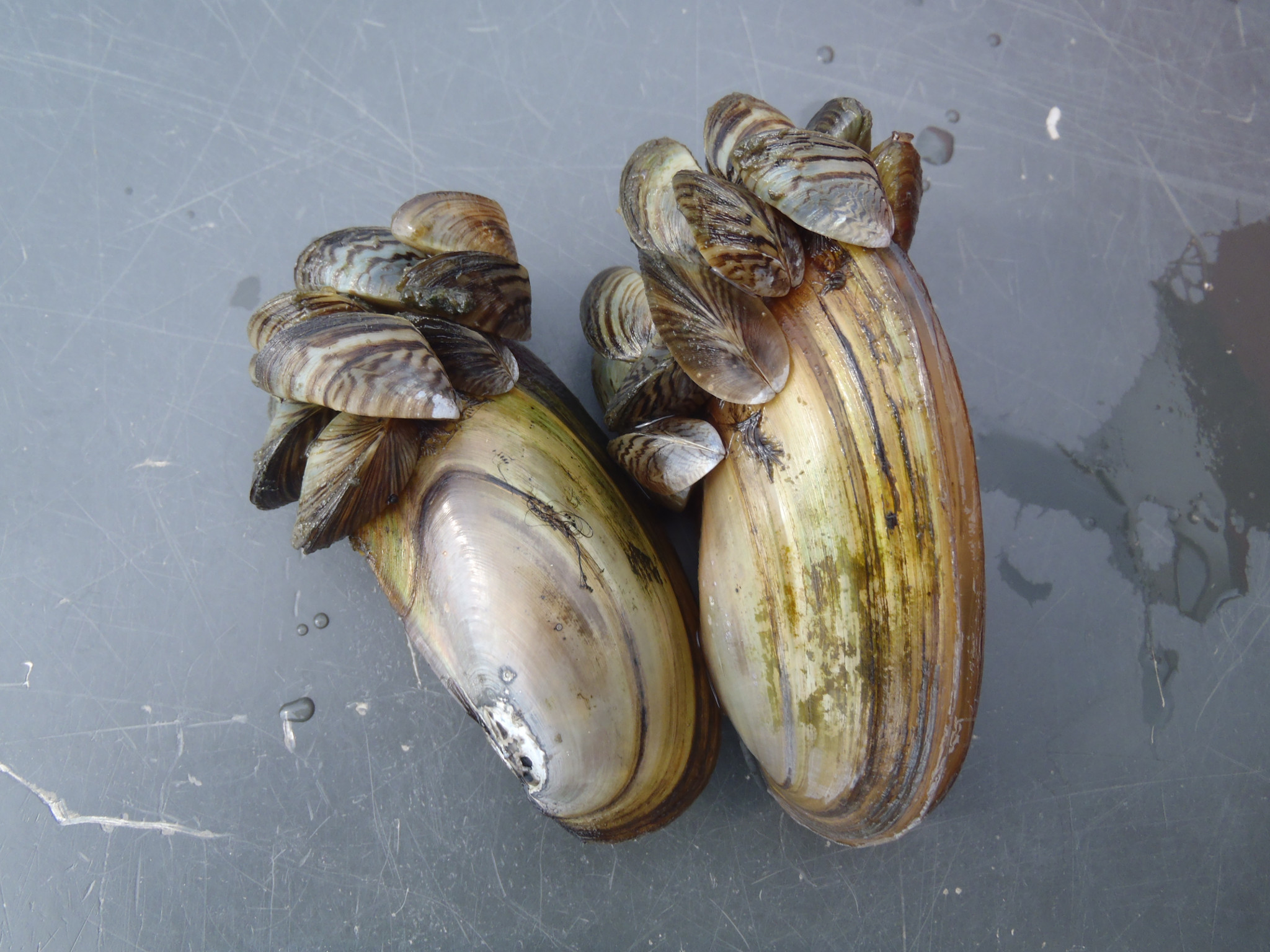Contact: Amy Kretlow, DNR Aquatic Invasive Species Monitoring Specialist
Amy.Kretlow@Wisconsin.gov or 920-838-2597
Invasive Zebra Mussels Detected In Aquarium Moss Balls
Retailers And Consumers Urged To Take Action To Prevent Spread Of Tiny Invasive Species With Big Impacts
 Zebra mussels can attach to any hard surface, such as the outside of a native mussels' shell. These native mussels are slowly smothered by the colony of invasive zebra mussels covering the opening of their shells.
Photo credit: Wisconsin DNR
Zebra mussels can attach to any hard surface, such as the outside of a native mussels' shell. These native mussels are slowly smothered by the colony of invasive zebra mussels covering the opening of their shells.
Photo credit: Wisconsin DNR
MADISON, Wis. – The Wisconsin Department of Natural Resources (DNR) is urging Wisconsinites to immediately remove and properly dispose of commercially purchased "moss balls" for aquariums after invasive zebra mussels were discovered inside and on some of these products in Wisconsin and across the United States. According to the U.S. Fish and Wildlife Service, zebra mussels are regarded as one of the most destructive invasive species in North America.
The invasive zebra mussels found in “moss balls” are designed for aquarium use and sold under names including “Betta Buddy Marimo Balls” and “Marimo Moss Ball Plant Grab N Go.”
“We are asking all pet stores and related retailers to please inspect and remove all these products from shelves,” said Amy Kretlow, DNR Aquatic Invasive Species Monitoring Specialist. “We are also asking any consumers who may have bought any moss ball products in the past month to please inspect and dispose of them properly; do not flush moss balls or contaminated water down toilets or drains.
Zebra mussels are an aquatic invasive species that can cause environmental and economic harm. These small, fingernail-sized mollusks native to the Caspian Sea region of Asia have three life stages – larval, juvenile and adult. In the larval stage, the mussels are microscopic and live freely in the water, allowing them to be easily transported. If released, these larvae can cause great harm to waterbodies. Adult zebra mussels can stay alive for several days outside of water and are common hitchhikers on boats, fishing equipment and aquarium plants.
Despite their small size, zebra mussels clog pipelines used for water filtration, render beaches unusable and damage boats. They also negatively impact aquatic ecosystems by harming native organisms.
The DNR is working with other states to determine where these products are being sold. Two major pet store chains, Petco and PetSmart, took quick action and removed the products from store shelves once notified. For more information regarding moss ball product recalls, visit Petco and PetSmart.
Wisconsin and other states will continue monitoring the situation to ensure a safe product is made available to the public.
DESTROY, DISPOSE, DRAIN
Do not dispose of the moss balls in drains, waterways or gardens. Moss balls must be destroyed and disposed of in a sealed container in the trash.
When following any of the methods listed below, ensure that the disposal method you choose is in compliance with your local state laws and animal welfare regulations.
DESTROY in one of three ways:
- Freeze – Place the moss ball into a sealable plastic bag and freeze for at least 24 hours.
- Boil – Place the moss ball in boiling water for at least 1 full minute.
- Bleach/Vinegar – Submerge the moss ball in chlorine bleach or undiluted white vinegar for 20 minutes.
DISPOSE of the moss ball and any of its packaging in a sealed plastic bag in the trash. If vinegar, boiling water or bleach was used, the liquid can be disposed down a household drain – never down a storm drain where it could enter and damage local waterways.
DRAIN and clean the aquarium, if moss balls were added to the aquarium.
Collect any fish or other living organisms and place them in another container, with water from a separate, uncontaminated water source. Sterilize the contaminated aquarium water by adding 1 cup of bleach for each gallon of water. Let the water sit for 10 minutes and then dispose the sterilized water down a household drain.
Clean the aquarium and accessories using one of the following methods, ensuring that the disposal method you choose is per manufacturers’ recommendations:
Boiling Method:
- Use water that is 140 degrees F to flush and coat the tank and all accessory surfaces, or
Disinfection Method:
- Make a disinfection solution using 3 tablespoons of bleach per gallon of water.
- Soak the aquarium, substrate, rocks, decor and filter media in the bleach water solution for 15 minutes.
- Rinse off all items before setting up the aquarium.
- Dispose of the previously used filter media and replace it with new media.
- Use a dechlorinating product to neutralize any residual chlorine before reintroducing aquatic life.
It is recommended that you do another water change within a week and continue to monitor the tank for any unusual or unexpected aquatic life.
For more information on the best management practices for decontaminating boats, equipment and gear to prevent the spread of aquatic invasive species (AIS) between waters, visit the DNR’s website.

